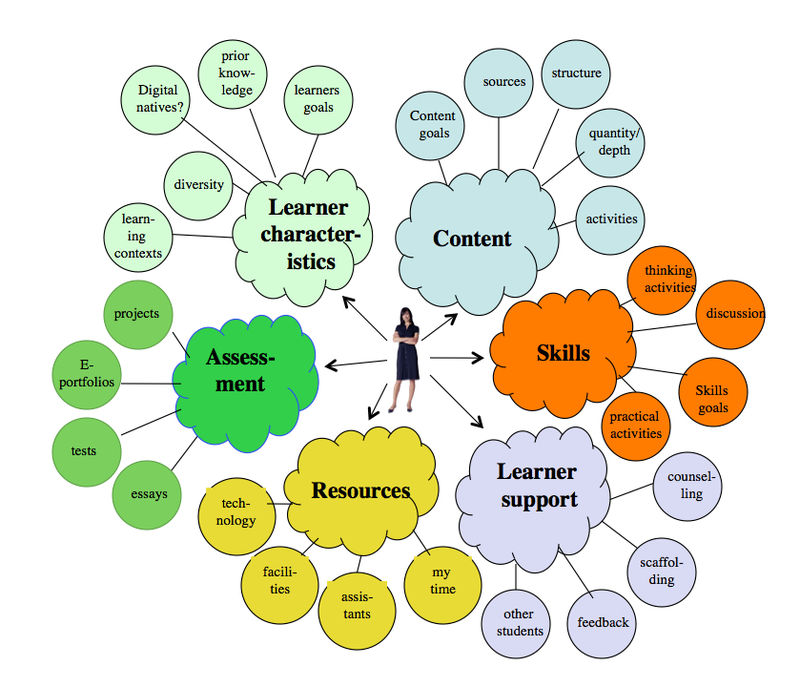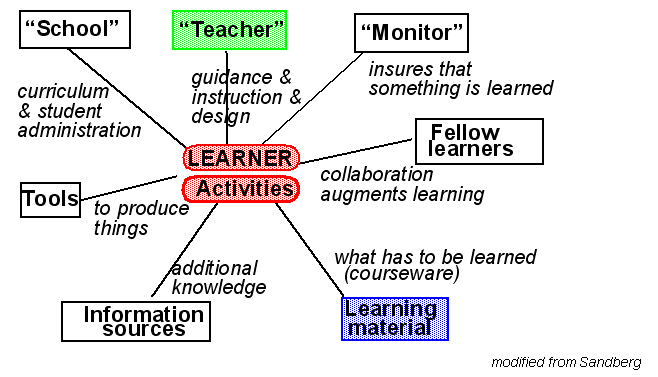Learning environment
 From EduTechWiki - Reading time: 3 min
From EduTechWiki - Reading time: 3 min
Definition[edit | edit source]
- Conceptually speaking, the Learning Environment refers to the whole range of components and activities within which learning happens.
- Technically speaking, a Learning Environment relies on computer-supported Systems such as a Learning management system, a combination of various educational technologies (including at least one communication module), virtual environments, ...
However, each kind of instructional design model has its own way of defining the learning environment. See also the discussion around technology enhanced learning
Functions of a Learning Environment[edit | edit source]
Sandberg's definition[edit | edit source]
(adapted by DSchneider)
- ``Teacher component: Its role is to provide something between loose guidance and direct instruction. It can be a human agent (present or distant), an intelligent agent, instructions like some text books provide, etc. This component provides information from the syllabus to the task level.
- ``Monitor component: Ensures that something is learned. A role taken by either the human teacher, the learner (self-control) or by some program.
- ``Fellow learners component: Improves the learning process (some research tries to implement artificial ones).
- ``Learning material, often Courseware: Contains what has to be learned in a very broad sense (knowing what, knowing how). It can be computational in various ways (exploratory hypertext, lesson and task oriented hypertext, simulation software, task solving environments, etc.).
- ``External information sources: All kinds of information which is not directly stored in the learning material (e.g. additional material, handbooks, manuals, etc.).
- ``Tools: Everything which may help the learning process other then the learning material (e.g. calculators, communication software, etc.)
- ``School [a category we added]: Something that provides a curriculum and does student administration.
Deschryver and Peraya[edit | edit source]
According to Deschryer and Peraya (note: Both work at TECFA, have to ask them a published reference), a learning and teaching environment (dispositif de formation) ought to implement six functions:
- inform
- communicate
- collaborate
- produce
- scaffold
- manage
Bates[edit | edit source]
Bates (2005) presents a concise model of the learning environment from the teacher's perspective.

Bates (2015:450) explains that this figure “illustrates one possible learning environment from the perspective of a teacher or instructor. A teacher may have little or no control over some components, such as learner characteristics or resources, but may have full control over other components such as choice of content and how learners will be supported. Within each of the main components there are a set of sub-components that will need to be considered. In fact, it is in the sub-components (content structure, practical activities, feedback, use of technology, assessment methods, and so on) where the real decisions need to be made.
I have listed just a few components in [the] Figure [..] and the set is not meant to be comprehensive. For instance it could have included other components, such as developing ethical behaviour, institutional factors, or external accreditation, each of which might also affect the learning environment in which a teacher or instructor has to work. Creating a model of a learning environment then is a heuristic device that aims to provide a comprehensive view of the whole teaching context for a particular course or program, by a particular instructor or teacher with a particular view of learning.”
References[edit | edit source]
- Bates, A. W. (2015). Teaching in a Digital Age: Guidelines for Designing Teaching and Learning, BCcampus. http://opentextbc.ca/teachinginadigitalage
- Sandberg, J. A. (1994). Educational paradigms: issues and trends. In Lewis, R. Mendelsohn, P., (ed.), Lessons from Learning, (IFIP TC3/WG3.3 Working Conference 1993), pages 13--22, Amsterdam. North-Holland.
- Basque, Josianne & Sylvie Doré (1998) Le concept d’environnement d’apprentissage informatisé, Journal of Distance Education/Revue de l'enseignement à distance, 13(1), ISSN 0830-0445, HTML
- OECD (2017), The OECD Handbook for Innovative Learning Environments, OECD Publishing, Paris. http://dx.doi.org/10.1787/9789264277274-en
 KSF
KSF